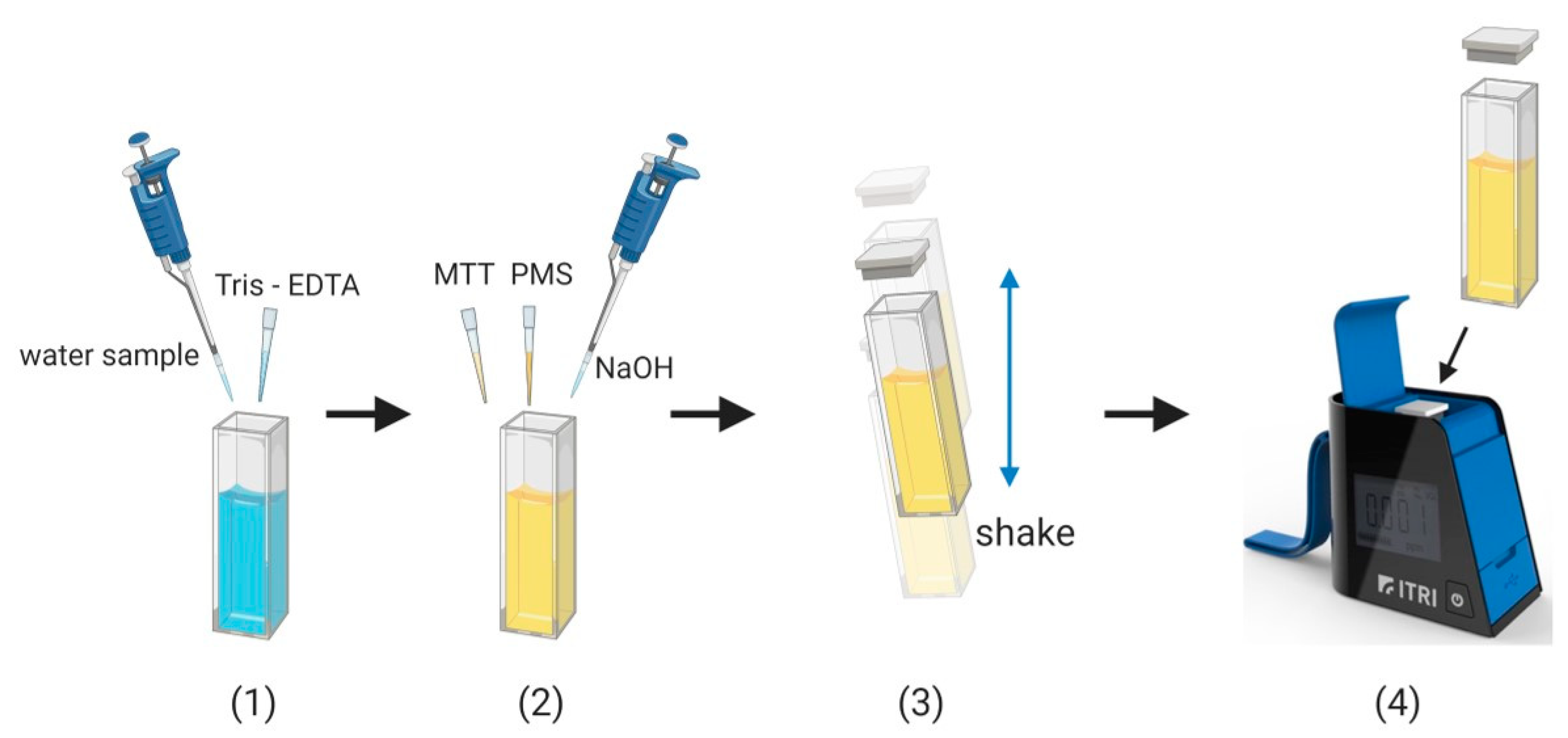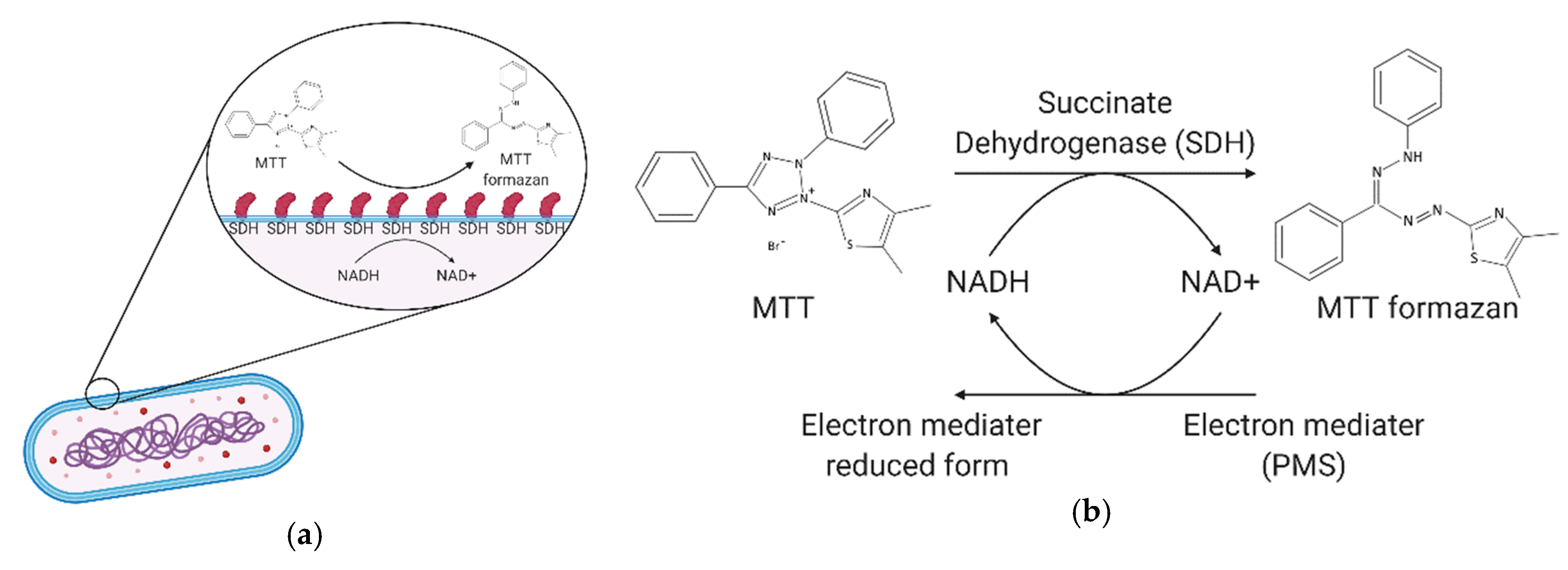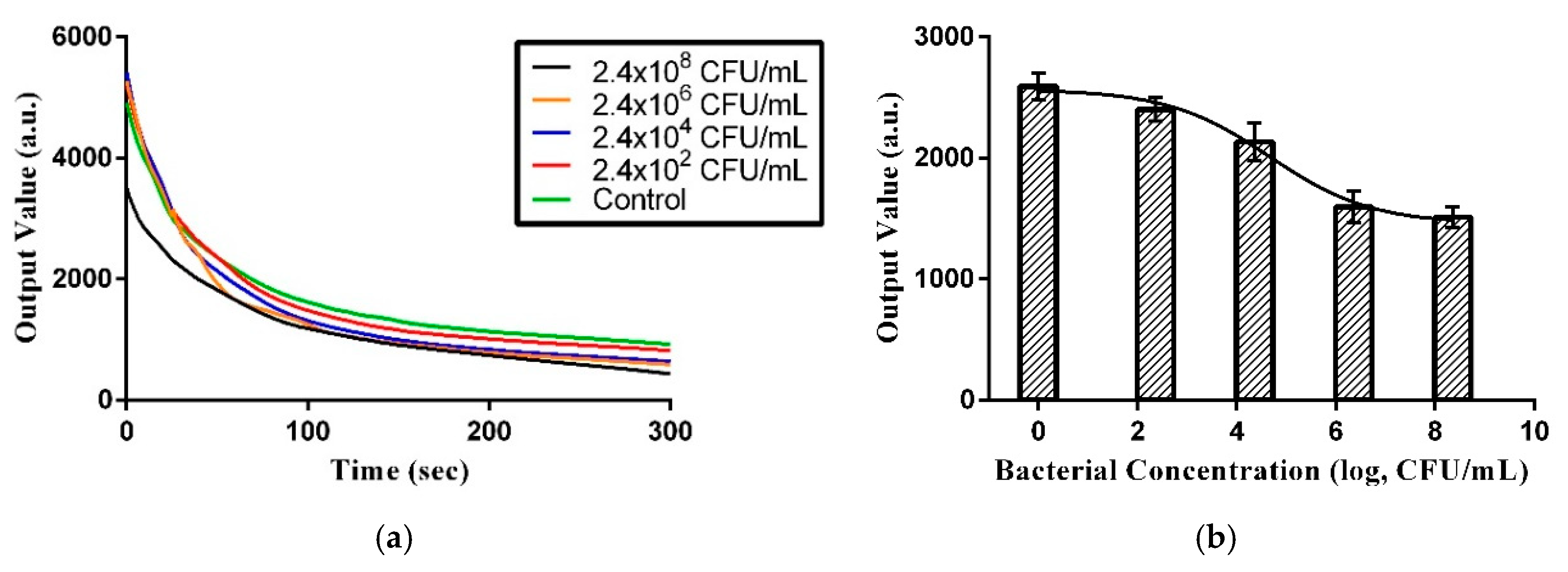Portable Device for Quick Detection of Viable Bacteria in Water
Abstract
1. Introduction
2. Materials and Methods
2.1. Reagents
2.2. Bacterial Colorimetric Device Design
2.3. Colorimetric Assays
3. Results and Discussion
3.1. Feasibility Analysis for Bacterial Reagent
3.2. Colorimetric Devicecalibration
4. Discussion
Author Contributions
Funding
Conflicts of Interest
References
- Howard, G.; Bartram, J.; Water, S.; Health, T.; World Health Organization. Domestic Water Quantity, Service Level and Health/Guy Howard and Jamie Bartram; World Health Organization: Geneva, Switzerland, 2003. [Google Scholar]
- United Nations Children’s Fund (UNICEF) WHO. Progress on Drinking Water Sanitation and Hygiene; World Health Organization (WHO): Geneva, Switzerland, 2017; p. 110. [Google Scholar]
- Borrego, J.J.; Moriñigo, M.A.; de Vicente, A.; Córnax, R.; Romero, P. Coliphages as an indicator of faecal pollution in water. Its relationship with indicator and pathogenic microorganisms. Water Res. 1987, 21, 1473–1480. [Google Scholar] [CrossRef]
- Lin, J.; Ganesh, A. Water quality indicators: Bacteria, coliphages, enteric viruses. Int. J. Environ. Health Res. 2013, 23, 484–506. [Google Scholar] [CrossRef]
- Ishii, S.; Sadowsky, M.J. Escherichia coli in the Environment: Implications for Water Quality and Human Health. Microbes Environ. 2008, 23, 101–108. [Google Scholar] [CrossRef]
- Lazcka, O.; Del Campo, F.J.; Munoz, F.X. Pathogen detection: A perspective of traditional methods and biosensors. Biosens. Bioelectron. 2007, 22, 1205–1217. [Google Scholar] [CrossRef] [PubMed]
- Rompré, A.; Servais, P.; Baudart, J.; de-Roubin, M.-R.; Laurent, P. Detection and enumeration of coliforms in drinking water: Current methods and emerging approaches. J. Microbiol. Methods 2002, 49, 31–54. [Google Scholar] [CrossRef]
- Ramakers, C.; Ruijter, J.M.; Deprez, R.H.L.; Moorman, A.F.M. Assumption-free analysis of quantitative real-time polymerase chain reaction (PCR) data. Neurosci. Lett. 2003, 339, 62–66. [Google Scholar] [CrossRef]
- Shih, C.M.; Chang, C.L.; Hsu, M.Y.; Lin, J.Y.; Kuan, C.M.; Wang, H.K.; Huang, C.T.; Chung, M.C.; Huang, K.C.; Hsu, C.E.; et al. Paper-based ELISA to rapidly detect Escherichia coli. Talanta 2015, 145, 2–5. [Google Scholar] [CrossRef]
- Piekarz, I.; Gorska, S.; Odrobina, S.; Drab, M.; Wincza, K.; Gamian, A.; Gruszczynski, S. A microwave matrix sensor for multipoint label-free Escherichia coli detection. Biosens. Bioelectron. 2020, 147, 111784. [Google Scholar] [CrossRef]
- Zheng, L.; Cai, G.; Wang, S.; Liao, M.; Li, Y.; Lin, J. A microfluidic colorimetric biosensor for rapid detection of Escherichia coli O157:H7 using gold nanoparticle aggregation and smart phone imaging. Biosens. Bioelectron. 2019, 124-125, 143–149. [Google Scholar] [CrossRef] [PubMed]
- Choi, J.R.; Hu, J.; Tang, R.; Gong, Y.; Feng, S.; Ren, H.; Wen, T.; Li, X.; Wan Abas, W.A.; Pingguan-Murphy, B.; et al. An integrated paper-based sample-to-answer biosensor for nucleic acid testing at the point of care. Lab Chip 2016, 16, 611–621. [Google Scholar] [CrossRef] [PubMed]
- Raymond, C.; Bartlett, M.M.; Brian, G. Acceleration of Tetrazolium Reduction by Bacteria. J. Clin. Microbiol. 1976, 3, 327–329. [Google Scholar]
- Cedillo-Rivera, R.; Ramirez, A.; Munoz, O. A rapid colorimetric assay with the tetrazolium salt MTT and phenazine methosulfate (PMS) for viability of Entamoeba histolytica. Arch. Med Res. 1992, 23, 59–61. [Google Scholar] [PubMed]
- Leive, L. The barrier function of the Gram-negative envelope. Ann. N. Y. Acad. Sci. 1974, 235, 109–129. [Google Scholar] [CrossRef] [PubMed]
- Kuan, C.M.; York, R.L.; Cheng, C.M. Lignocellulose-based analytical devices: Bamboo as an analytical platform for chemical detection. Sci. Rep. 2015, 5, 18570. [Google Scholar] [CrossRef]
- Matsuura, K.; Huang, H.-W.; Chen, M.-C.; Chen, Y.; Cheng, C.-M. Relationship between Porcine Sperm Motility and Sperm Enzymatic Activity using Paper-based Devices. Sci. Rep. 2017, 7, 46213. [Google Scholar] [CrossRef]
- Matsuura, K.; Wang, W.-H.; Ching, A.; Chen, Y.; Cheng, C.-M. Paper-Based Resazurin Assay of Inhibitor-Treated Porcine Sperm. Micromachines 2019, 10, 495. [Google Scholar] [CrossRef]
- Scott Sutton, P.D. Counting Colonies. Available online: http://www.microbiologynetwork.com/counting-colonies.asp (accessed on 1 January 2006).
- Kralik, P.; Slana, I.; Kralova, A.; Babak, V.; Whitlock, R.; Pavlik, I. Development of a predictive model for detection of Mycobacterium avium subsp paratuberculosis in faeces by quantitative real time PCR. Vet. Microbiol. 2010, 149, 133–138. [Google Scholar] [CrossRef]
- Kralik, P.; Ricchi, M. A Basic Guide to Real Time PCR in Microbial Diagnostics: Definitions, Parameters, and Everything. Front. Microbiol. 2017, 8. [Google Scholar] [CrossRef]
- Slana, I.; Kralik, P.; Kralova, A.; Pavlik, I. On-farm spread of Mycobacterium avium subsp. paratuberculosis in raw milk studied by IS900 and F57 competitive real time quantitative PCR and culture examination. Int. J. Food Microbiol. 2008, 128, 250–257. [Google Scholar] [CrossRef]
- Cavaiuolo, M.; Paramithiotis, S.; Drosinos, E.H.; Ferrante, A. Development and optimization of an ELISA based method to detect Listeria monocytogenes and Escherichia coli O157 in fresh vegetables. Anal. Methods 2013, 5, 4622–4627. [Google Scholar] [CrossRef]
- Feng, M.; Yong, Q.; Wang, W.; Kuang, H.; Wang, L.; Xu, C. Development of a monoclonal antibody-based ELISA to detect Escherichia coli O157:H7. Food Agric. Immunol. 2013, 24, 481–487. [Google Scholar] [CrossRef]
- Kong, D.; Liu, L.; Xing, C.; Kuang, H.; Xu, C. Sensitive and highly specific detection of Cronobacter sakazakii based on monoclonal sandwich ELISA. Food Agric. Immunol. 2015, 26, 566–576. [Google Scholar] [CrossRef]
- Sun, J.; Huang, J.; Li, Y.; Lv, J.; Ding, X. A simple and rapid colorimetric bacteria detection method based on bacterial inhibition of glucose oxidase-catalyzed reaction. Talanta 2019, 197, 304–309. [Google Scholar] [CrossRef] [PubMed]
- Miranda, O.R.; Li, X.; Garcia-Gonzalez, L.; Zhu, Z.-J.; Yan, B.; Bunz, U.H.F.; Rotello, V.M. Colorimetric Bacteria Sensing Using a Supramolecular Enzyme–Nanoparticle Biosensor. J. Am. Chem. Soc. 2011, 133, 9650–9653. [Google Scholar] [CrossRef] [PubMed]
- Safavieh, M.; Ahmed, M.U.; Sokullu, E.; Ng, A.; Braescu, L.; Zourob, M. A simple cassette as point-of-care diagnostic device for naked-eye colorimetric bacteria detection. Analyst 2014, 139, 482–487. [Google Scholar] [CrossRef]
- Alhogail, S.; Suaifan, G.A.R.Y.; Zourob, M. Rapid colorimetric sensing platform for the detection of Listeria monocytogenes foodborne pathogen. Biosens. Bioelectron. 2016, 86, 1061–1066. [Google Scholar] [CrossRef]
- Kettering, C.F. Spectroscopic Characteristics and Some Chemical Properties of IV-Methylphenazinium Methyl Sulfate (Phenazine Methosulfate) and Pyocyanine at the Semiquinoid Oxidation Level. Biol. Chem. 1964, 239, 3964–3970. [Google Scholar]
- EOS. ES 3494: Chilled Fish; Egyptian Organization for Standardization and Quality: Cairo, Egypt, 2005. [Google Scholar]
- Eltholth, M.; Fornace, K.; Grace, D.; Rushton, J.; Häsler, B. Assessing the chemical and microbiological quality of farmed tilapia in Egyptian fresh fish markets. Glob. Food Secur. 2018, 17, 14–20. [Google Scholar] [CrossRef]
- Gołaś, I.; Szmyt, M.; Potorski, J.; Łopata, M.; Gotkowska-Płachta, A.; Glińska-Lewczuk, K. Distribution of Pseudomonas fluorescens and Aeromonas hydrophila Bacteria in a Recirculating Aquaculture System during Farming of European Grayling (Thymallus thymallus L.) Broodstock. Water 2019, 11, 376. [Google Scholar] [CrossRef]
- Anita; Kumar, A.; Verma, A.K.; Gupta, M.K.; Rahal, A. Multidrug resistant pathogenic Escherichia coli status in water sources and Yamuna River in and around Mathura, India. Pakistan J. Biol. Sci. PJBS 2014, 17, 540–544. [Google Scholar] [CrossRef]
- Kilunga, P.I.; Kayembe, J.M.; Laffite, A.; Thevenon, F.; Devarajan, N.; Mulaji, C.K.; Mubedi, J.I.; Yav, Z.G.; Otamonga, J.P.; Mpiana, P.T.; et al. The impact of hospital and urban wastewaters on the bacteriological contamination of the water resources in Kinshasa, Democratic Republic of Congo. J. Environ. Sci. Health A Toxic Hazard. Subst. Environ. Eng. 2016, 51, 1034–1042. [Google Scholar] [CrossRef] [PubMed]
- Kayembe, J.M.; Thevenon, F.; Laffite, A.; Sivalingam, P.; Ngelinkoto, P.; Mulaji, C.K.; Otamonga, J.P.; Mubedi, J.I.; Poté, J. High levels of faecal contamination in drinking groundwater and recreational water due to poor sanitation, in the sub-rural neighbourhoods of Kinshasa, Democratic Republic of the Congo. Int. J. Hyg. Environ. Health 2018, 221, 400–408. [Google Scholar] [CrossRef] [PubMed]






| Method | Time | Cost | LOD |
|---|---|---|---|
| Multi-tube fermentation | A few days | Low | <3–103 MPN/100 mL |
| spread-plate | A few days | Low | 30 CFU/cm2 [19] |
| q-PCR | A few hours | High | 102–104 cells/gram [20,21] units and tens cells/mL [22] |
| ELISA | A few hours | High | 103–105 CFU/mL [23,24,25] with a few hours of enrichment <1 CFU/gram [24,25] |
| Portable device with bacteria detection reagent | <15 min | Low | 105–106 CFU/mL |
Publisher’s Note: MDPI stays neutral with regard to jurisdictional claims in published maps and institutional affiliations. |
© 2020 by the authors. Licensee MDPI, Basel, Switzerland. This article is an open access article distributed under the terms and conditions of the Creative Commons Attribution (CC BY) license (http://creativecommons.org/licenses/by/4.0/).
Share and Cite
Liao, Y.-H.; Muthuramalingam, K.; Tung, K.-H.; Chuan, H.-H.; Liang, K.-Y.; Hsu, C.-P.; Cheng, C.-M. Portable Device for Quick Detection of Viable Bacteria in Water. Micromachines 2020, 11, 1079. https://doi.org/10.3390/mi11121079
Liao Y-H, Muthuramalingam K, Tung K-H, Chuan H-H, Liang K-Y, Hsu C-P, Cheng C-M. Portable Device for Quick Detection of Viable Bacteria in Water. Micromachines. 2020; 11(12):1079. https://doi.org/10.3390/mi11121079
Chicago/Turabian StyleLiao, Yu-Hsiang, Karthickraj Muthuramalingam, Kuo-Hao Tung, Ho-Hsien Chuan, Ko-Yuan Liang, Chen-Peng Hsu, and Chao-Min Cheng. 2020. "Portable Device for Quick Detection of Viable Bacteria in Water" Micromachines 11, no. 12: 1079. https://doi.org/10.3390/mi11121079
APA StyleLiao, Y.-H., Muthuramalingam, K., Tung, K.-H., Chuan, H.-H., Liang, K.-Y., Hsu, C.-P., & Cheng, C.-M. (2020). Portable Device for Quick Detection of Viable Bacteria in Water. Micromachines, 11(12), 1079. https://doi.org/10.3390/mi11121079







